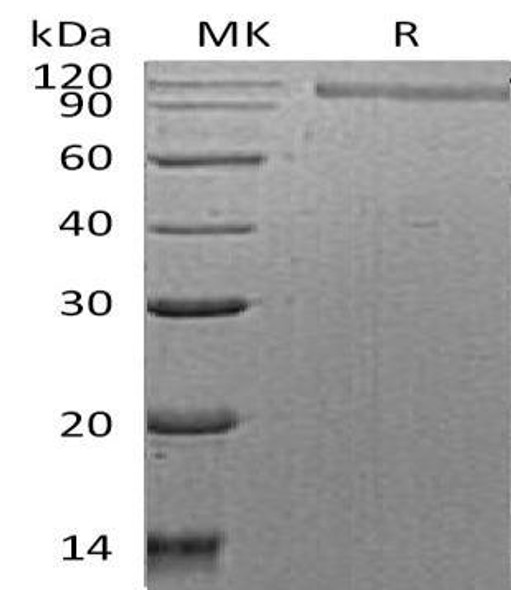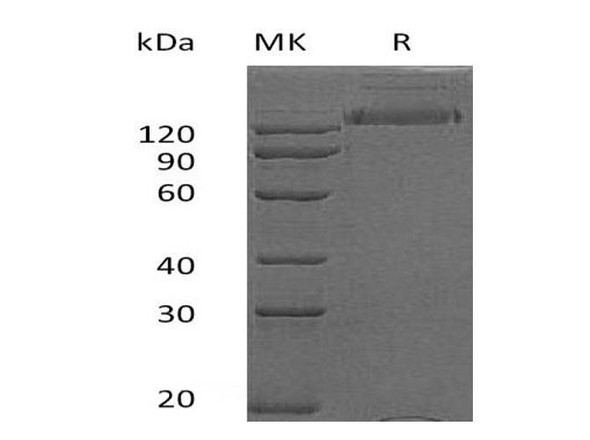Enzymes Recombinant Proteins
Human ErbB2 Recombinant Protein (RPPB2506)
- SKU:
- RPPB2506
- Product Type:
- Recombinant Protein
- Species:
- Human
- Uniprot:
- P04626
- Research Area:
- Enzymes
Description
| Product Name: | Human ErbB2 Recombinant Protein |
| Product Code: | RPPB2506 |
| Size: | 5µg |
| Species: | Human |
| Target: | ErbB2 |
| Synonyms: | Receptor tyrosine-protein kinase erbB-2, EC 2.7.10.1, p185erbB2, C-erbB-2, NEU proto-oncogene, Tyrosine kinase-type cell surface receptor HER2, MLN 19, CD340 antigen, NEU, NGL, HER2, TKR1, HER-2, c-erb B2, HER-2/neu. |
| Source: | Sf9 Insect cells |
| Physical Appearance: | Sterile Filtered clear solution. |
| Formulation: | ErbB2 protein solution (0.25mg/ml) containing Phosphate Buffered Saline (pH 7.4) and 10% glycerol. |
| Stability: | Store at 4°C if entire vial will be used within 2-4 weeks. Store, frozen at -20°C for longer periods of time. For long term storage it is recommended to add a carrier protein (0.1% HSA or BSA).Avoid multiple freeze-thaw cycles. |
| Purity: | Greater than 85.0% as determined by SDS-PAGE. |
| Amino Acid Sequence: | TQVCTGTDMK LRLPASPETH LDMLRHLYQG CQVVQGNLEL TYLPTNASLS FLQDIQEVQG YVLIAHNQVR QVPLQRLRIV RGTQLFEDNY ALAVLDNGDP LNNTTPVTGA SPGGLRELQL RSLTEILKGG VLIQRNPQLC YQDTILWKDI FHKNNQLALT LIDTNRSRAC HPCSPMCKGS RCWGESSEDC QSLTRTVCAG GCARCKGPLP TDCCHEQCAA GCTGPKHSDC LACLHFNHSG ICELHCPALV TYNTDTFESM PNPEGRYTFG ASCVTACPYN YLSTDVGSCT LVCPLHNQEV TAEDGTQRCE KCSKPCARVC YGLGMEHLRE VRAVTSANIQ EFAGCKKIFG SLAFLPESFD GDPASNTAPL QPEQLQVFET LEEITGYLYI SAWPDSLPDL SVFQNLQVIR GRILHNGAYS LTLQGLGISW LGLRSLRELG SGLALIHHNT HLCFVHTVPW DQLFRNPHQA LLHTANRPED ECVGEGLACH QLCARGHCWG PGPTQCVNCS QFLRGQECVE ECRVLQGLPR EYVNARHCLP CHPECQPQNG SVTCFGPEAD QCVACAHYKD PPFCVARCPS GVKPDLSYMP IWKFPDEEGA CQPCPINCTH SCVDLDDKGC PAEQRASPLT LEHHHHHH |
HER-2/neu (erbB-2) encodes an 185-kDa orphan receptor tyrosine kinase that is constitutively active as a dimer and displays potent oncogenic activity when overexpressed. Herstatin, as the product of alternative HER-2 transcript, retains intron 8.The herstatin mRNA is expressed in normal human fetal kidney and liver, but is at reduced levels relative to p185HER-2 mRNA in carcinoma cells that contain an amplified HER-2 gene. Herstatin appears to be an inhibitor of p185HER-2, because it disrupts dimers, reduces tyrosine phosphorylation of p185, and inhibits the anchorage-independent growth of transformed cells that overexpress HER-2.
ErbB2 Human Recombinant produced in Sf9 Baculovirus cells is a single, glycosylated polypeptide chain containing 638 amino acids (23-652) and having a molecular mass of 70.4kDa (Molecular size on SDS-PAGE will appear at approximately 70-100kDa). ErbB2 is fused to 8 amino acid IgG His-Tag at C-terminus and purified by proprietary chromatographic techniques.�
| UniProt Protein Function: | HER2: a proto-oncogenic receptor tyrosine kinase of the EGFR family. Essential component of a neuregulin-receptor complex, although neuregulins do not interact with it alone. Not activated by EGF, TGF- alpha and amphiregulin. Amplified in breast cancer. Overexpression induces constitutive activity, and the gene is amplified or overexpressed in up to 30% of breast cancers, correlating with poor survival. The antibody Herceptin is approved for treatment of metastatic breast cancer with HER2 amplification/overexpression. Somatic mutations seen in 4% of lung cancers and also in breast, gastric, ovarian cancer and glioblastoma. One SNP shows predisposition to breast and gastric cancer. Inhibitors: Herceptin, lapatinib, PKI-166, EKB-569, CI-1033. |
| UniProt Protein Details: | Protein type:EC 2.7.10.1; EGFR family; Kinase, protein; Membrane protein, integral; Oncoprotein; Protein kinase, TK; Protein kinase, tyrosine (receptor); TK group Chromosomal Location of Human Ortholog: 17q12 Cellular Component: basolateral plasma membrane; cytoplasm; endosome membrane; nucleus; plasma membrane; receptor complex Molecular Function:ErbB-3 class receptor binding; growth factor binding; identical protein binding; phosphatidylinositol-4,5-bisphosphate 3-kinase activity; protein binding; protein C-terminus binding; protein heterodimerization activity; protein phosphatase binding; protein-tyrosine kinase activity; Ras guanyl-nucleotide exchange factor activity; transmembrane receptor activity; transmembrane receptor protein tyrosine kinase activity Biological Process: cell proliferation; cell surface receptor linked signal transduction; enzyme linked receptor protein signaling pathway; MAPKKK cascade; phosphoinositide 3-kinase cascade; phosphoinositide-mediated signaling; positive regulation of cell adhesion; positive regulation of cell growth; positive regulation of epithelial cell proliferation; positive regulation of GTPase activity; positive regulation of MAP kinase activity; positive regulation of protein amino acid phosphorylation; positive regulation of transcription from RNA polymerase I promoter; positive regulation of transcription from RNA polymerase III promoter; positive regulation of translation; protein amino acid autophosphorylation; protein amino acid phosphorylation; regulation of microtubule-based process; regulation of phosphoinositide 3-kinase cascade; signal transduction; transmembrane receptor protein tyrosine kinase signaling pathway; wound healing Disease: Gastric Cancer; Glioma Susceptibility 1; Lung Cancer |
| NCBI Summary: | This gene encodes a member of the epidermal growth factor (EGF) receptor family of receptor tyrosine kinases. This protein has no ligand binding domain of its own and therefore cannot bind growth factors. However, it does bind tightly to other ligand-bound EGF receptor family members to form a heterodimer, stabilizing ligand binding and enhancing kinase-mediated activation of downstream signalling pathways, such as those involving mitogen-activated protein kinase and phosphatidylinositol-3 kinase. Allelic variations at amino acid positions 654 and 655 of isoform a (positions 624 and 625 of isoform b) have been reported, with the most common allele, Ile654/Ile655, shown here. Amplification and/or overexpression of this gene has been reported in numerous cancers, including breast and ovarian tumors. Alternative splicing results in several additional transcript variants, some encoding different isoforms and others that have not been fully characterized. [provided by RefSeq, Jul 2008] |
| UniProt Code: | P04626 |
| NCBI GenInfo Identifier: | 119533 |
| NCBI Gene ID: | 2064 |
| NCBI Accession: | P04626.1 |
| UniProt Secondary Accession: | P04626,Q14256, Q6LDV1, Q9UMK4, B2RZG3, B4DHN3, X5D2V5 |
| UniProt Related Accession: | P04626 |
| Molecular Weight: | 97,382 Da |
| NCBI Full Name: | Receptor tyrosine-protein kinase erbB-2 |
| NCBI Synonym Full Names: | erb-b2 receptor tyrosine kinase 2 |
| NCBI Official Symbol: | ERBB2�� |
| NCBI Official Synonym Symbols: | NEU; NGL; HER2; TKR1; CD340; HER-2; MLN 19; HER-2/neu�� |
| NCBI Protein Information: | receptor tyrosine-protein kinase erbB-2 |
| UniProt Protein Name: | Receptor tyrosine-protein kinase erbB-2 |
| UniProt Synonym Protein Names: | Metastatic lymph node gene 19 protein; MLN 19; Proto-oncogene Neu; Proto-oncogene c-ErbB-2; Tyrosine kinase-type cell surface receptor HER2; p185erbB2; CD_antigen: CD340 |
| UniProt Gene Name: | ERBB2�� |






